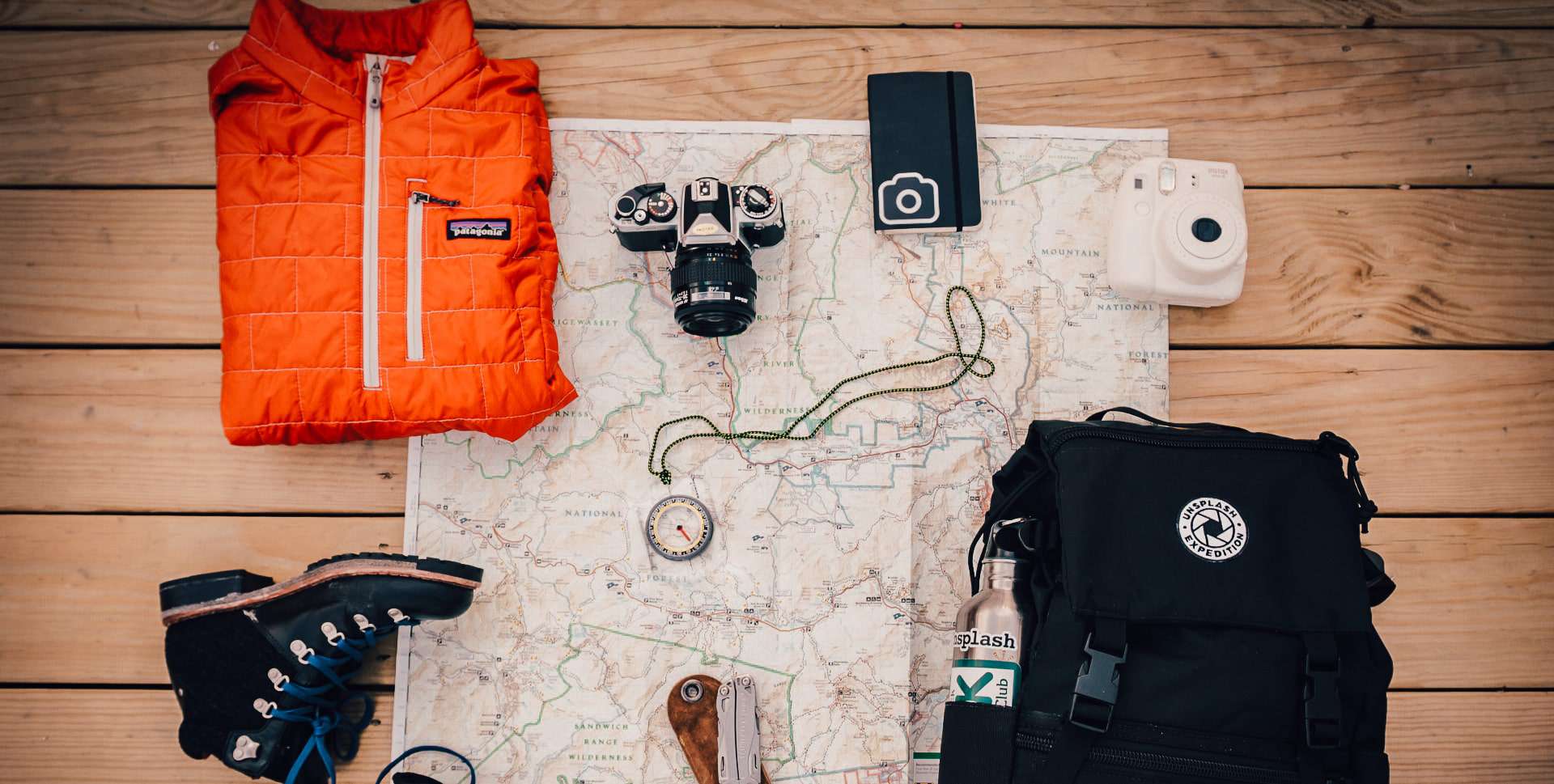For campers and hikers starting out, the question “will I need this?” can be quite daunting. You need to find a balance between being prepared and being a pack mule.
Knowing what you need to take with you camping is a skill that is learned through experience. The more you venture out, the better able you will be to do away with any unnecessary weight.
The 10 essentials for hiking are a great starting point when packing your bag as the equipment listed is intended to help you survive in the wilderness.
The Origins of the Ten Essentials
In 1974, The Mountaineers first introduced the Ten Essentials list in the third edition of their handbook for outdoor adventuring “Mountaineering: The Freedom of the Hills” [1]. Since then the list has been updated and improved to more accurately prepare explorers for the wilderness.
The list emerged as part of a conversation the group had been having dating back to the 1930s and the climbing courses the organisation ran. The Mountaineers wanted to know if it was possible to respond to an emergency in a positive manner and safely spend a night outdoors.
The essentials list is a way to educate recreationists to give them the best tools possible to respond to an emergency situation. Not everything listed will be needed every trip, but the intention is that all items here can be a lifesaver in an emergency.
Different organizations also offer their own version of the Ten Essentials. The American Hiking Society [2] list appropriate footwear as part of their essentials, but most other lists regard footwear as something that goes on before the hike starts rather than an essential to bring with you.
The list used here is the updated version and includes:
But as we will see, the ten essentials don’t cover everything – so I’ve included 7 extras to bring at the end!
Navigation
Modern technology, such as GPS devices, has made hiking and outdoor recreation easier than ever. However, as impressive (and fun) as the new gadgets are, make sure to bring the old reliable methods as a back-up. As the saying goes: two is one, one is none.
Related: Looking for an easy start to camping in a group? Check out the best 3 room tents for families and groups.
Map
Knowing how to read a topographical map [3] is a vital skill for many outdoor pursuits. A topographic map will include information about the shape and contours of the earth, such as land elevation, trails and paths, and forestry.
You can view topographic maps online and buy digital copies. However, physical paper copies should be prioritized. Unlike digital maps and GPS, they will not be reliant on electricity.
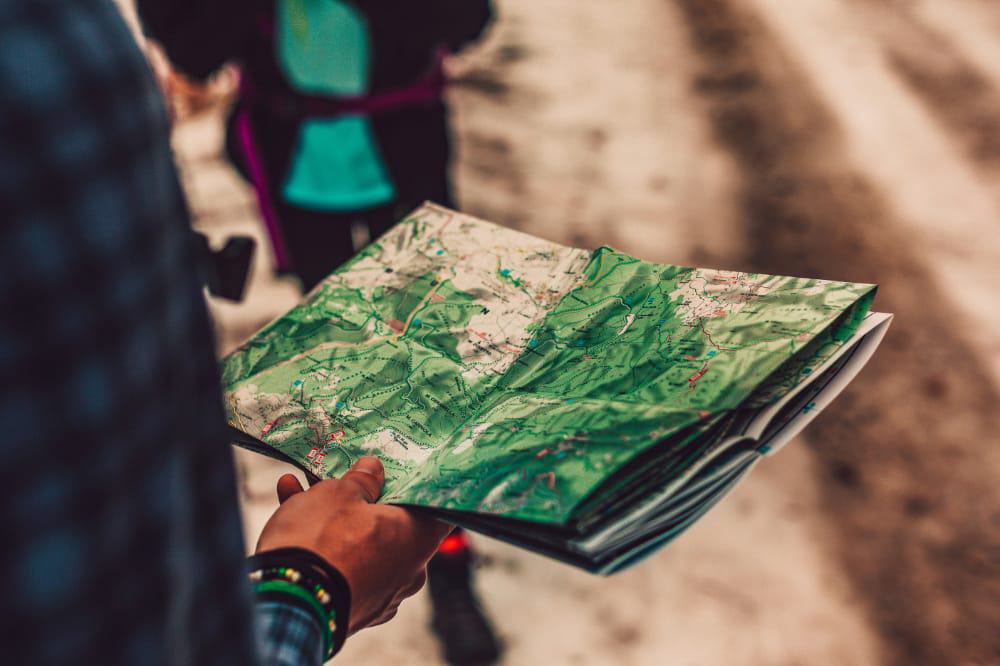
In the US, topographical maps that cover hiking trails are available from either National Geographic Maps [4] or Green Trail Maps. Ordnance Survey (OS) maps are the standard map of choice for outdoor activity in the UK.
Compass
An essential tool to help read a map, compasses are reliable, old-fashioned tools for navigation.
Like maps, digital versions are available that you can download onto your phone or smart device but obviously these rely on battery power. Make sure to bring a standard analogue compass with you, even if you plan to primarily use a digital compass.
GPS
Purpose-built GPS devices are often fairly rugged and weatherproof. They have been designed for outdoor pursuits. Other devices that come equipped with GPS functionality, such as smartphones are fragile to the weather and their battery often drains quickly.
Tip: Make sure to download any required maps before the trip
Altimeter watch
If you are struggling to locate yourself on a map, perhaps due to poor weather conditions causing visibility issues, an altimeter watch can be key to finding your way.
Altimeter watches contain a barometric sensor that measures air pressure to give a close estimation of elevation. Once you know how high you are, you can start using that as a point of reference for the map.
Personal Locator Beacon (PBL) or satellite messenger
In case of an emergency, this can be used to alert emergency services. Sending a signal to emergency personnel, these devices can reliably inform them of your position.
Consider downloading the what3words app [5] before you leave as well in case you need to contact emergency services. The app provides a three word code that can be used to relay your position to rescue teams – much easier than trying to describe what the rocks around you look like if you’re lost!
All backcountry travelers should carry some method of contacting emergency services.
Illumination
It can get pretty dark at night when you’re out in the backcountry so make sure to bring some sort of light source. You can take a lantern or a flashlight, but it’s strongly recommended that you bring a headlamp if possible.
Because of their hands-free nature, headlamps offer you much more flexibility than other options.
If your headlamp comes with a tiltable setting (as most do) you can also adjust your lighting easily to focus on objects close to you (when you’re cooking for example).
If you’re looking to buy a headlamp, search for LED ones with red-light power settings (which aren’t as bright and save power). Any outdoor shop should carry weatherproof headlamps intended for taking into the wilderness.
Tip: Make sure that whatever light source you bring, you store it in a handy place. If you arrive at your campsite in the dark, you don’t want to dig deep into your bag to find it!
Sun Protection
From the dark of night to the light of day!
I love the sunshine as much as the next person, but it can get dangerous when you’re exposed to it for too long.
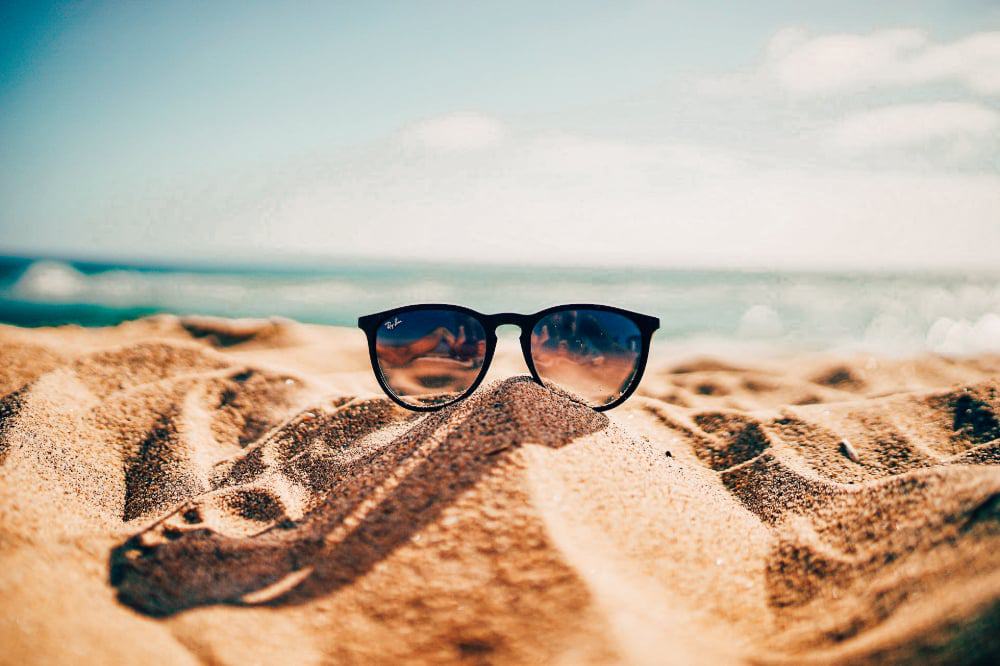
Sunglasses
Not just a fabulous fashion accessory to make you a style icon, sunglasses offer important protection from the dangers of the sun. For full protection, you want a pair of sunglasses that will block out around 99% of UV light.
Tip: Most opticians will test your sunglasses before you go on your trip if you’re unsure
A Lesson from Reinhold
Insane, superhuman Reinhold Messner fell into trouble one trip.
For the uninitiated, he was the first person to: ascend Mount Everest solo; ascend all peaks over 8,000 meters (26,000 ft) above sea level; and cross Antarctica and Greenland with neither snowmobiles nor dog sleds.
You get the idea about what kind of guy he is.
He had been taking off his goggles to film his companion throughout one trip up Everest. This was a huge mistake. The wind and the sunburned his corneas leading them to become inflamed and painful at night as his vision deteriorated to temporary blindness.
Messner panicked. He became convinced that it was the lack of oxygen malfunctioning his brain causing him to be blind forever. If it hadn’t been for his companions caring for him that night, it’s unlikely Messner would have survived.
If the author of more than 80 books about his experiences climbing and exploring the wilderness can suffer for not using his sun protection correctly, so can you.
Sunscreen
According to the World Health Organisation [6] one in five Americans will develop skin cancer in their lifetime. The Skin Cancer Foundation [7] recommends daily use of SPF 15 sunscreen which can reduce your risk of developing skin cancer by 50%.
So when you’re out in the wilderness and exposing yourself to the weather, make sure that you bring sunscreen to protect your skin!
Tip: Make sure your sunscreen blocks UVA (causes skin aging and cancer) and UVB rays (causes sunburn)!
As part of your preparation for the trip, you can check the UV forecast. UV rays can penetrate through clouds so make sure to check the UV index forecast as well as the weather forecast. The Met Office [8] provide reliable forecasts for the UK and the EPA [9] forecast UV rays in the USA.
Sun Protection Factor (SPF) is based on the time it takes for UV-exposed skin to redden and burn. It does not measure UVA rays, only UVB.
Everyone is different in how much protection they will need from their sunscreen. It’s recommended to take sunscreen with at least SPF 30 rating, but some people might need more.
Health conditions and new medication can cause extra sensitivity to the sun’s rays, so factor that in when picking a sunscreen. As someone who rather arrogantly ignored my doctor when she told me a new medication would make my skin more sensitive to UV radiation, I urge you to listen to medical advice. Unless you want to spend a sleepless night fighting off Hell’s Itch [10]…
Apply your sunscreen 20 minutes before exposure to allow it to work properly. Make sure all exposed skin is covered including places you might not think about like under your chin and nose.
Sweating can limit sunscreens’ ability to stay on the skin. Around 80 minutes of water resistance is the best you can hope for so make sure to reapply frequently.
Clothing
Some synthetic clothing comes with an Ultraviolet Protection Factor (UPF) rating. UPF indicates how much UV radiation (bother UVA and UVB) the clothing will allow to reach your skin.
For example, UPF 50 will block about 98% of the sun’s rays.
There can be huge differences in the UPF of clothing. A white T-shirt has a rating of about 7, but if it’s wet it drops to 3 (meaning a third of the sun’s rays will pass through to the skin).
A dark, long-sleeved denim shirt on the other hand offers almost total protection with a rating of about 1,700.
Tip: Hats are essential for providing coverage to your head, particularly your scalp which can be otherwise difficult to protect.
Some people might prefer to use long-sleeved clothing with high UPF ratings rather than sunscreen, even when it’s hot.
First Aid Kit
Most outdoor retailers will offer first aid kits intended for camping or hiking. These kits are great but make sure to personalize your kit to cater for any individual needs you might have.
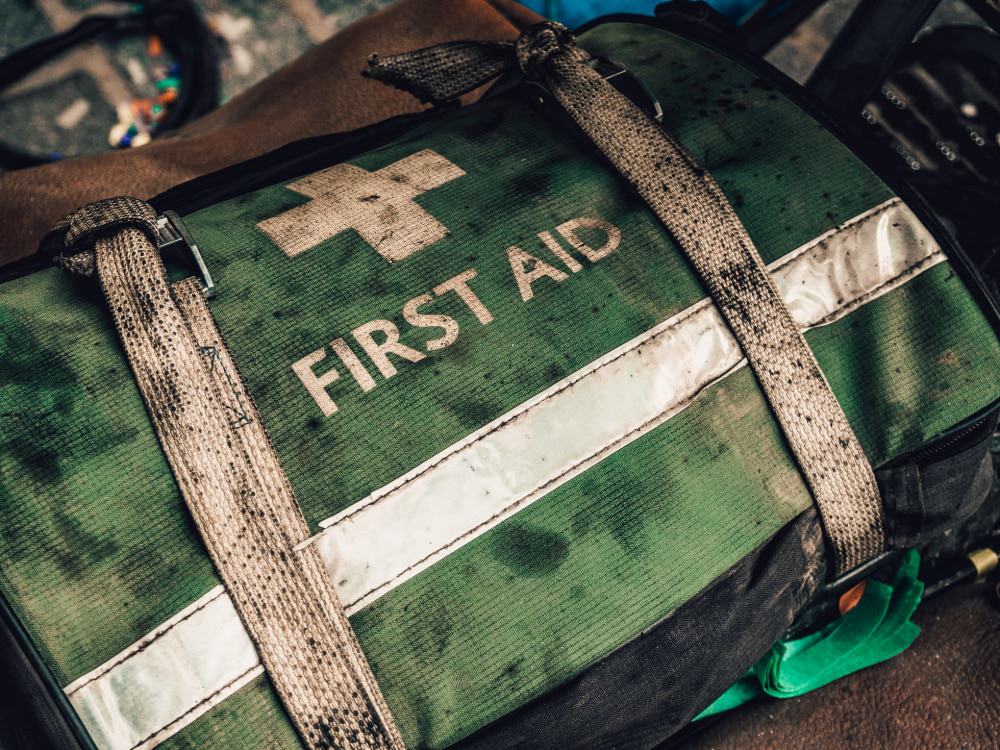
Here’s a list of some essential items your kit should contain:
- Bandages
- Gauze pads and dressing
- Tape
- Antiseptic
- Blister treatment
- Nitrile gloves
- Tweezers
- Painkillers and anti-inflammatories (paracetamol and ibuprofen)
- Anti-diarrheal solution
- Antihistamine tablets
Take into account what terrain you will be crossing when packing your first aid kit. For example, in Scotland heather dominates so much of the landscape – which is beautiful!
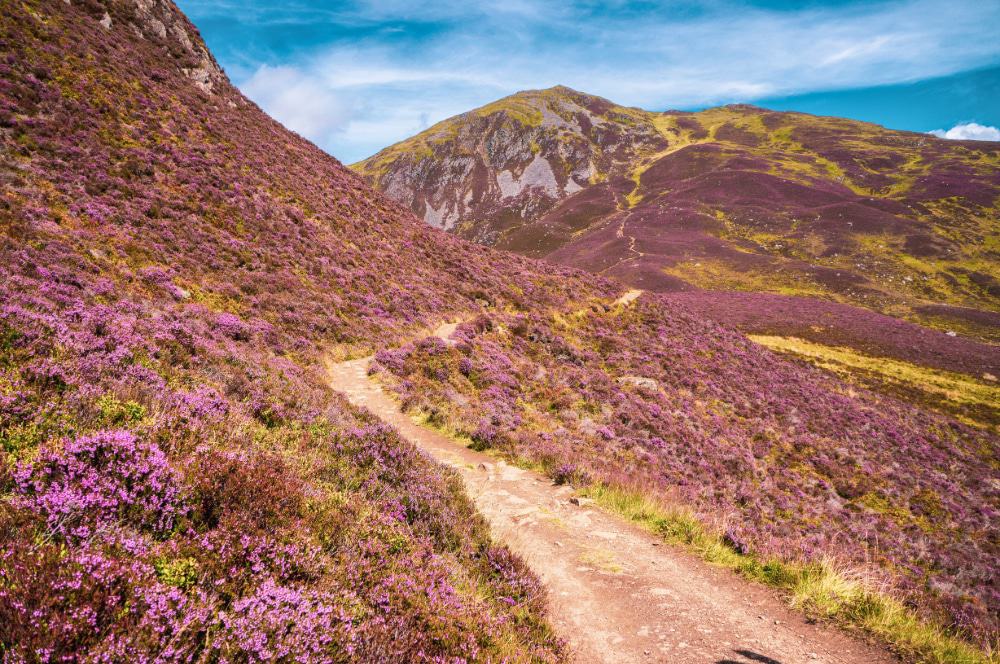
However, ticks often live in heather and can latch themselves onto hikers passing through. Ticks can carry harmful bacteria and cause illnesses such as Lyme Disease [11].
Knowing this, I always make sure to take a good set of tweezers with me so I can remove any of the damned blood suckers.
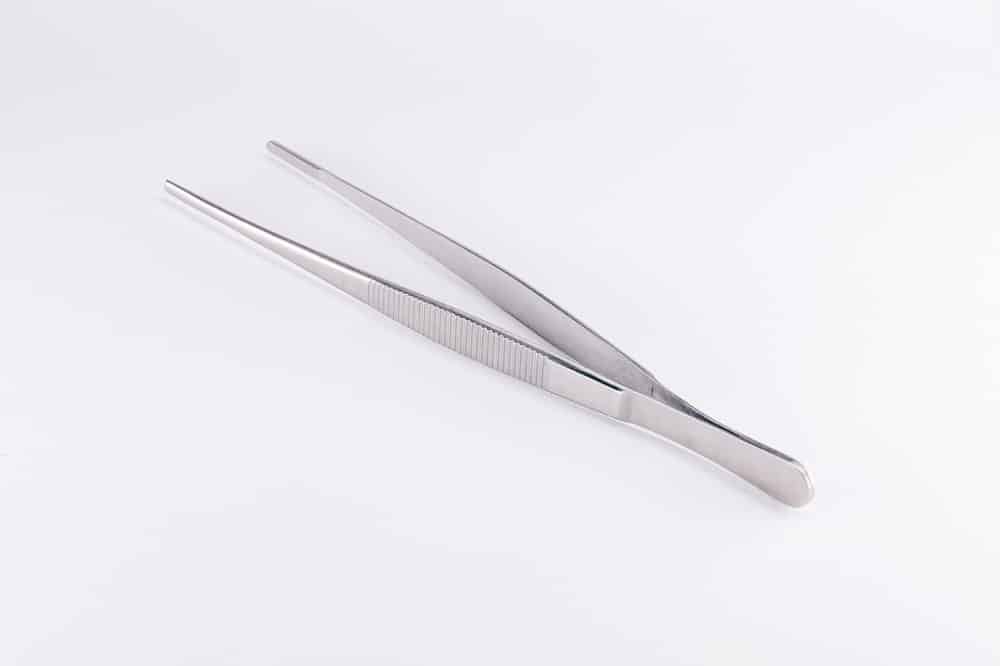
If you find a tick, don’t panic! Here’s how to remove it safely:
- Grasp the tick as close to the skin’s surface as possible with the tweezers
- Pull upward with steady, even pressure – don’t twist or jerk!
- After removal, clean the bite and your hands with rubbing alcohol or soap and water
- Don’t crush the tick – dispose of it another way, like placing it in a sealed bag or container
Knife
Every adult on expeditions in the backcountry should carry a knife. They are vital tools for food preparation, first aid application, fire starting, and other emergencies that might arise.
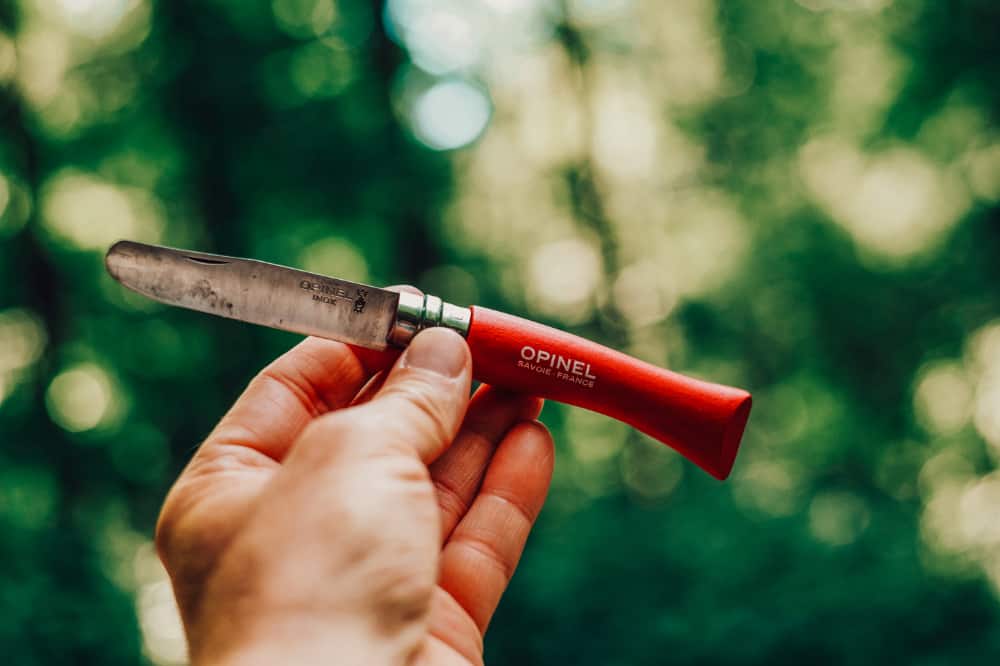
Single, foldout blades are fine but if possible seek out a multitool that combines different tools into one handy, pocket-sized unit. Multitools often come with pliers, screwdrivers, and scissors among other tools.
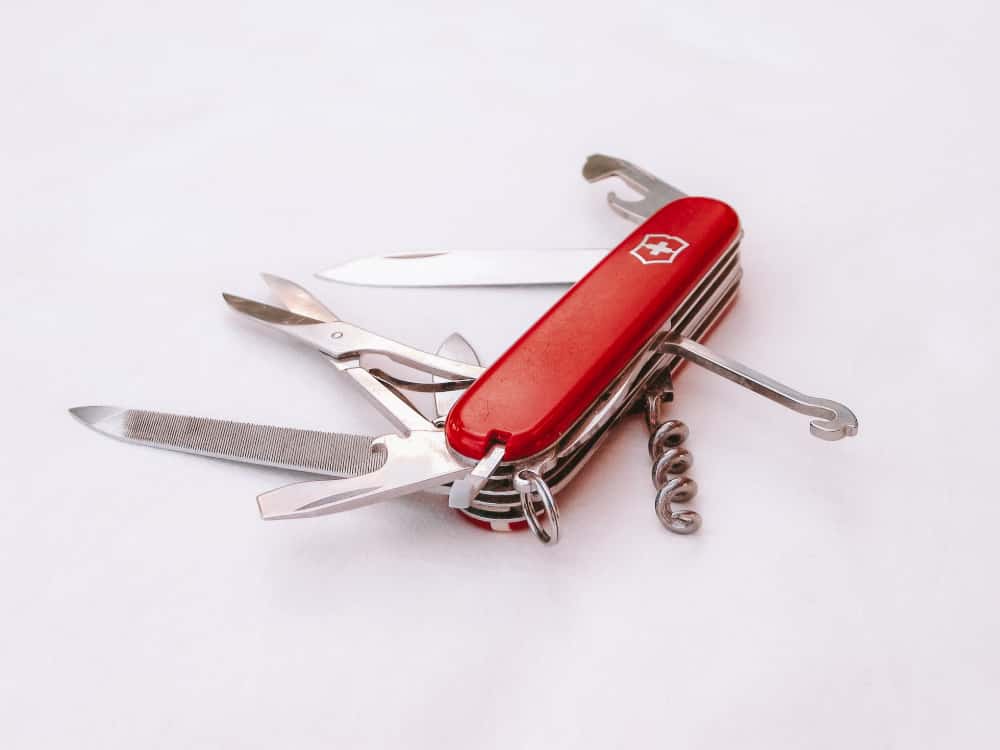
Don’t take a knife thats blade can’t be stored safely – the last thing you want is an accident involving your tent and a wayward knife!
Fire
Make sure that you bring something to start a fire with you in case of an emergency. For advice on how to start a campfire, I’ve already written a step-by-step guide!
Many people opt for butane lighters which can vary dramatically in quality and reliability.
Matches are another option to consider but are vulnerable to wet weather. Waterproof and windproof matches are available and often come in waterproof containers. If you are bringing matches, seek out weatherproof matches designed for outdoor use.

Firestarters ignite quickly and are indispensable for lighting wet wood.
If you are venturing beyond the treeline or out into the snow, where firewood will not be as readily available, it’s recommended to bring a stove as an emergency heat source.
Emergency Shelter
This is an important “worst-case-scenario” bit of kit. You want to do as much as possible to avoid getting into a situation where you need to use an emergency shelter – but you have to be prepared in case you do!
A tent is only an emergency shelter if you are carrying it with you at all times – if you’re hiking during the day away from your tent you need to make sure to bring another shelter with you.
The ideal choice is a bivy sack, or to give it its proper name, a “bivouac sack”. These are lightweight, portable, waterproof shelters ideal for emergency use when hiking. Some modern fabrics (such as Gore-Tex [12]) allow some humidity to pass through whilst blocking water from getting in, solving the issue of condensation that older bivy sacks suffer from.
Some lightweight tarp and rope can be used to make a shelter in an emergency. Space blankets, or Mylar blankets, are good for reducing heat loss but won’t be much use as a shelter to sleep in.
If you are hiking on a busy path where you would expect to be rescued before having to spend the night camped out, a space blanket will probably do a good job of keeping you warm whilst you wait.
But if you think there’s a chance you could be spending the night, then a bivy sack is the best choice for an emergency shelter.
Related: Looking for a tent that can handle even the tallest members of the group? We’ve reviewed the best tent for tall person.
Extra Food
In the event you do have to spend some time in your emergency shelter, you’ll be grateful for any extra food you bring with you! Aim to bring an extra day’s worth of food with you if possible.
Meals and snacks that don’t require cooking and have a long shelf life (and won’t spoil in your daysack) are ideal. Plenty of energy bars, for example, can help sustain you when facing an emergency.
Remember that, if you’re bringing food that could go off, there are a number of important safety steps. We’ve written a guide on keeping food cold while camping to avoid any nasty accidents.
Extra Water
Just as you’ll be thankful for some extra food, make sure you have extra water with you.
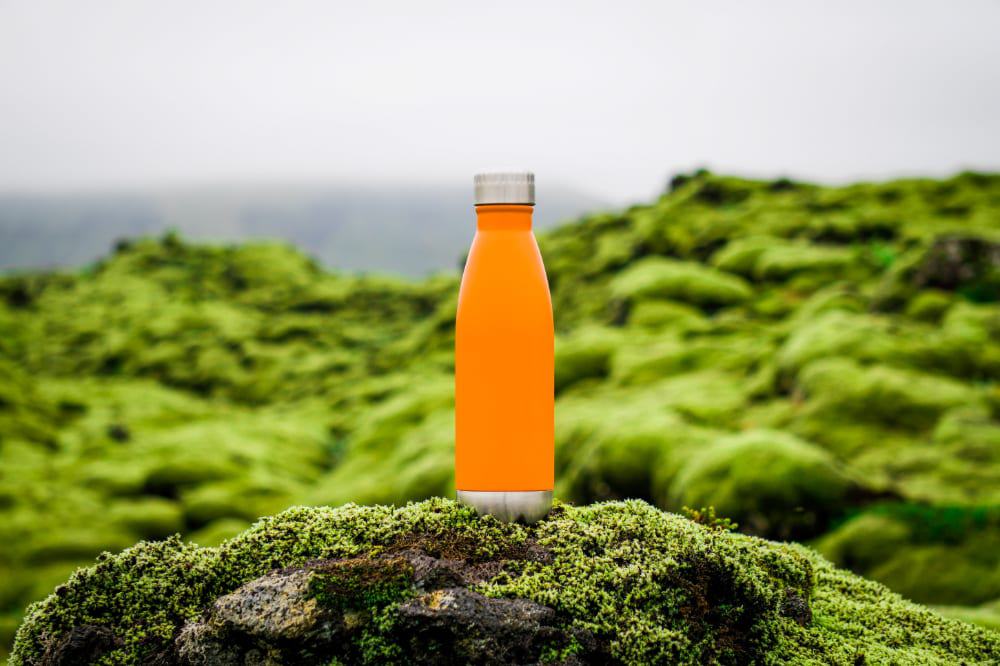
It’s important to fill your water container before you leave for any hike.
Thankfully here in Scotland we have abundant sources of fresh drinking water, with over 125,000km of rivers and streams [13]. Like many others, on long hikes I stop regularly at streams to refill my container.
Whenever possible I try to follow the water downstream for some distance to make sure that nothing unsavoury is floating in the river just out of sight.
Much of the Scottish highlands are used for sheep grazing and it’s not unheard of to occasionally stumble across some poor sheep who has shuffled off their mortal coil and now floats along a river or loch.
Try to avoid water sources with dead things in them when filling up your container.
Tip: Wide-mouth containers are easier for refilling!
But in many places around the world, drinking directly from a stream can be dangerous. Rivers in the US are often infected with parasites such as Giardia [14] that can cause diarrheal illness (not something you want during a night in your bivy sack waiting for rescue…).
There are ways to make the water safe for drinking. You can bring a filter to treat the water which is good for clear water sources.
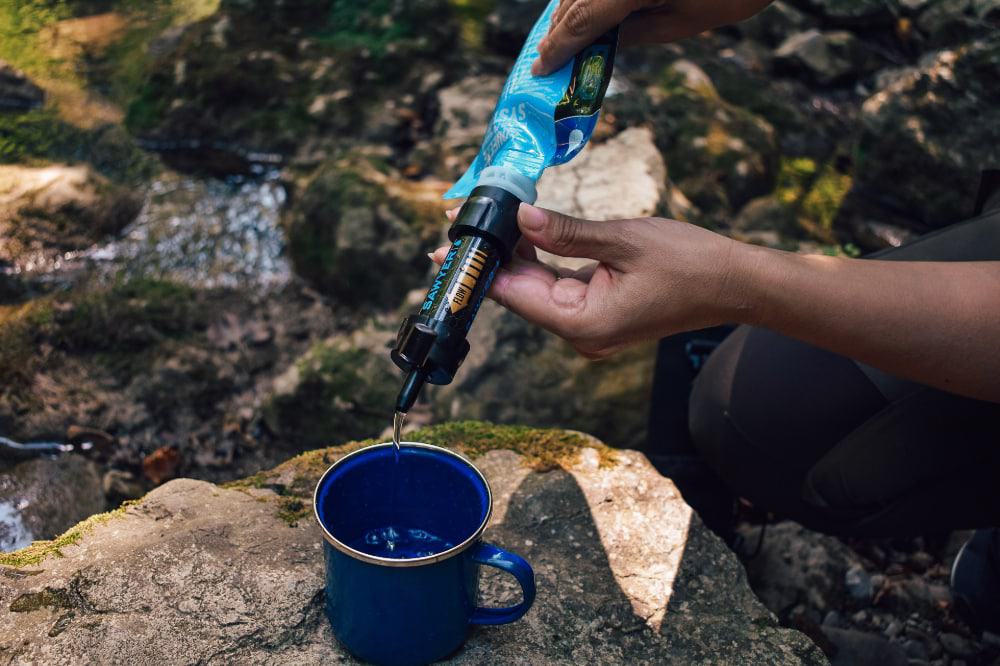
Alternatively, chemical purification tablets are available that will kill bacteria and viruses in the water. Chemical purification is better for larger groups requiring more water and for more risky water sources.
Tip: Chlorine dioxide tablets are favored over chlorine tablets as they have no noticeable aftertaste.
Whether or not you need to treat your water before you drink it will depend on where you are. It’s always a good idea to bring some water purification tablets with you, however, given how easily they can be carried.
It’s also important to remember that if the weather has been particularly dry, there might be less easily accessible rivers or streams to use for drinking water. Rivers on maps might run dry in the summer so be prepared for less water being available.
Extra Clothes
You should pack suitable extra clothes for your trip. A spare base layer in case it gets wet is always a good idea.
A good, waterproof rain jacket is definitely an essential piece of clothing for your trip. Aim for something lightweight that can sit on top of multiple layers.
Some people like ponchos because they can cover your bag and keep it dry as well. Due to their relaxed fit, ponchos are also good for keeping cool. But often they leave your arms exposed and won’t be much protection from the wind.
I recommend investing in a good quality rain jacket and a rain cover for your bag, if you’re worried about your gear getting wet. Ponchos are cheaper alternatives but don’t have the durability of a quality rain jacket.
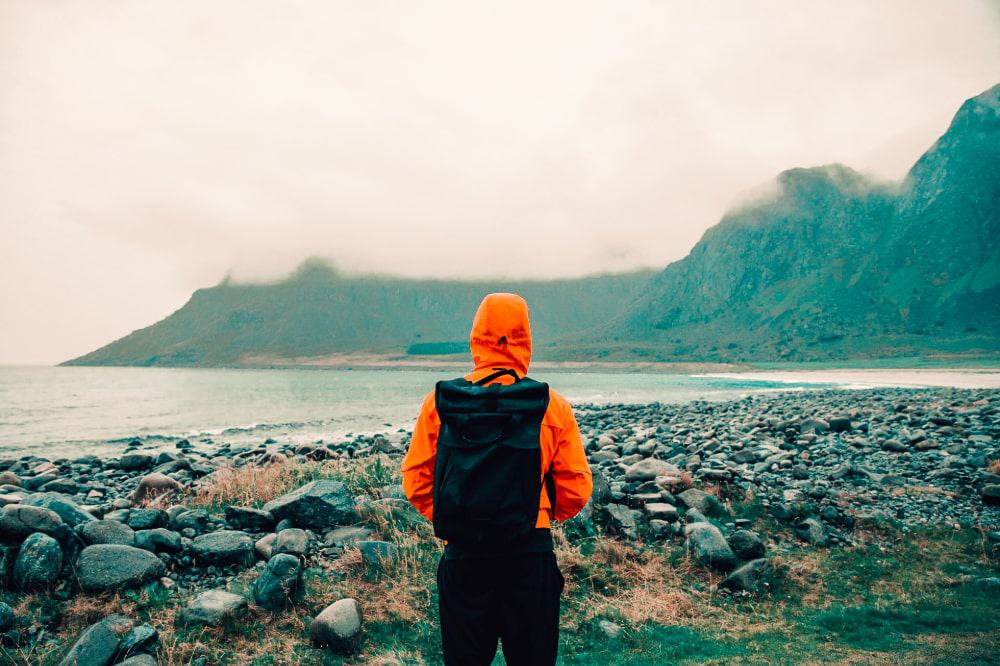
During colder expeditions then it would be a good idea to bring another layer for insulation with you. This is especially important if you find yourself caught in an emergency that causes you to be inactive.
Seven Extras People Forget
The Ten Essentials list is a handy starting point for your trip. But once you’ve taken care of these essentials, ask yourself if anything is missing?
No list is going to be able to cover everything you could possibly need. Each trip is unique – even if you’re heading to familiar terrain, the weather might be different.
Research and prepare!
Each time you escape into the wilderness, you need to consider the specifics of your trip. Some things might seem obvious and just require a tweak to the list.
For example, I would probably need to take less water with me trekking in Scotland than someone hiking trails in Utah. This is common sense – it’s a lot hotter and drier than Utah than the Scottish highlands, so of course you should take more water!
Writing this article I decided to look at the Zion National Park website [15] to see if there was anything else I might need to be aware of for my imaginary trip.
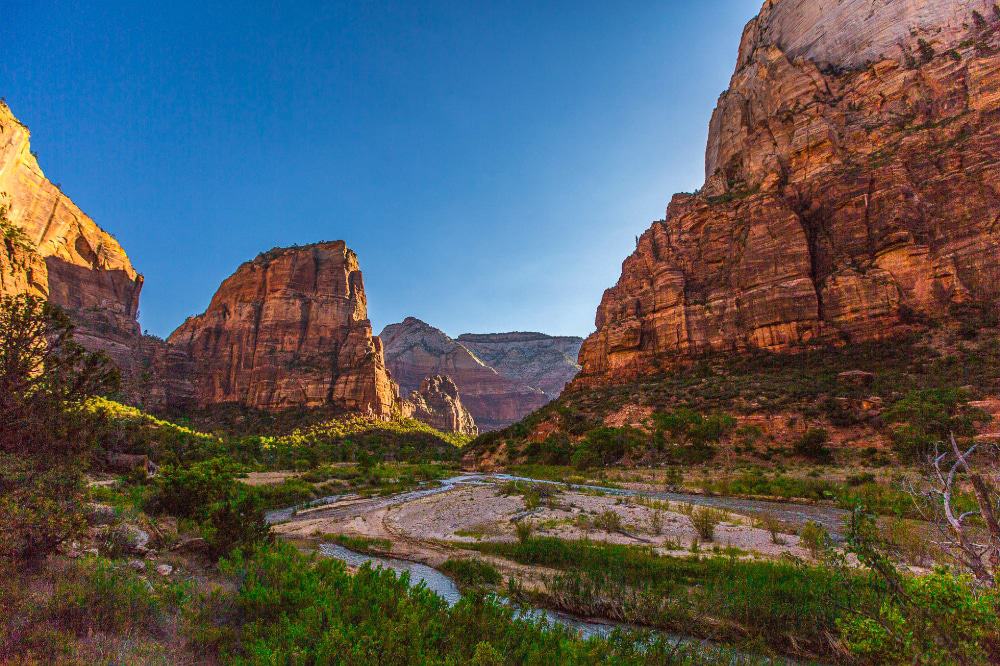
As suspected, they had further advice that would have been helpful for my make-believe adventure I was planning as I looked out my rain-speckled window.
Currently, there is an issue with cyanobacteria [16] blooming in the Virgin River making the water unsafe to drink – even with filtration systems! So although I would have brought extra water with me, I might have to bring even more if I can’t filter water I find.
Make sure to do plenty of research into what else you might need to bring with you before the essentials.
7 Extra Items to Bring With You
Power Pack
Even if you have navigation and communication devices for emergencies, bring a power pack for charging mobile phones. Once you are safe again, they can be used for communication with anyone who might be worried about you not checking in.
Tissues
A packet of pocket tissues weighs almost nothing and can be a welcome “comfort” in emergencies. If you use them as toilet paper, remember to Leave No Trace and pack it out.
Trash bags
Bring a trash bag to store any waste until you can responsibly dispose of it. You can also consider picking up any trash you see littering the landscape on your hike and do your part to save the great outdoors!
Flask
It might not be essential to bring a flask of hot tea or coffee, but it’s definitely a good idea for colder trips! If you are able to get a fire going and bring a spare teabag with you, you can brew some hot tea to help keep you warm through the night.
Insect repellant
In emergencies, it’s important to keep a calm head. It’s a lot easier to keep calm and focus when you aren’t being eaten alive by bugs!
Duct Tape
A repair kit on a roll! Duct tape can be used to seal up holes in tents or jackets (temporarily) as well as make a splint if anyone is injured.
Pen and Notebook
A notebook can be used to log any landmarks you pass if you get lost off-trail. It can also be used to play tic-tac-toe or hangman as you wait for rescue.
Use things properly
Having all of this lifesaving equipment with you is great – but if you can’t use it properly it’s just going to be a lot of deadweight.
Try testing out your emergency shelter in a park or garden before you go into the backcountry. You want to feel comfortable that you can set it up and get shelter from it in harsh conditions.
You might not be able to replicate a storm but you can consider taking your bivy sack out in the rain, for example.
Map and compass reading skills don’t come naturally to everyone. You can try to learn how to reap a map online [17] or recreationist organisations often run navigation courses. Personally I think these courses are a great way to be assured in your own abilities.
Tip: Try using a map and compass to navigate through familiar terrain to make sure you have the hang of it before heading into the backcountry.
Knowing what else you might need to bring and how to use your equipment correctly will come with experience for many hikers and campers.
But if you put in as much research and preparation as possible before you go, you give yourself the best chance of staying safe in case of an emergency.
Wrapping It All Up
The Ten Essentials are not everything you will need for a successful trip into the backcountry. But they will go a long way to making sure that in an emergency situation you are as prepared as possible.
Remember to consider the specifics of the terrain you are venturing into as well when planning your ten essentials. It’s all good and well having the equipment but make sure you know how to use it before you head out into the backcountry!
Have fun – and stay safe!
References
[1] https://www.mountaineers.org/books/books/mountaineering-the-freedom-of-the-hills-9th-edition-1
[2] https://americanhiking.org/resources/10essentials/
[3] https://cpb-us-e1.wpmucdn.com/sites.ucsc.edu/dist/c/12/files/2015/10/ContourWhat_Lecture.pdf
[4] https://www.natgeomaps.com/trail-maps/trails-illustrated-maps
[5] https://what3words.com/products/what3words-app/
[6] https://www.who.int/news-room/q-a-detail/ultraviolet-(uv)-radiation-and-skin-cancer#:~:text=Currently%2C%20between%202%20and%203,skin%20cancer%20in%20their%20lifetime.
[7] https://www.skincancer.org/skin-cancer-information/skin-cancer-facts/#:~:text=39-,Regular%20daily%20use%20of%20an%20SPF%2015%20or%20higher%20sunscreen,developing%20melanoma%20by%2050%20percent.&text=Melanoma%20accounts%20for%207%20percent,new%20cancer%20cases%20in%20women.&text=Men%20age%2049%20and%20under,melanoma%20than%20any%20other%20cancer.
[8] https://www.metoffice.gov.uk/public/weather/uv-index-forecast/#?tab=map&map=MaxUVIndex&zoom=5&lon=-4.00&lat=55.71&fcTime=1598216400
[9] https://www.epa.gov/sunsafety/uv-index-1
[10] https://wtop.com/news/2019/06/relieving-sunburn-itch-aka-hells-itch/
[11] https://www.cdc.gov/ticks/tickbornediseases/lyme.html
[12] https://www.mrsec.psu.edu/content/gore-tex-faqs
[13] https://www.environment.gov.scot/our-environment/water/scotland-s-freshwater/
[14] https://www.cdc.gov/healthywater/drinking/travel/index.html
[15] https://www.nps.gov/zion/planyourvisit/toxic-cyanobacteria-bloom-in-the-virgin-river-and-the-streams-of-zion-national-park.htm
[16] https://ucmp.berkeley.edu/bacteria/cyanointro.html
[17] https://www.open.edu/openlearn/society-politics-law/geography/map-reading
